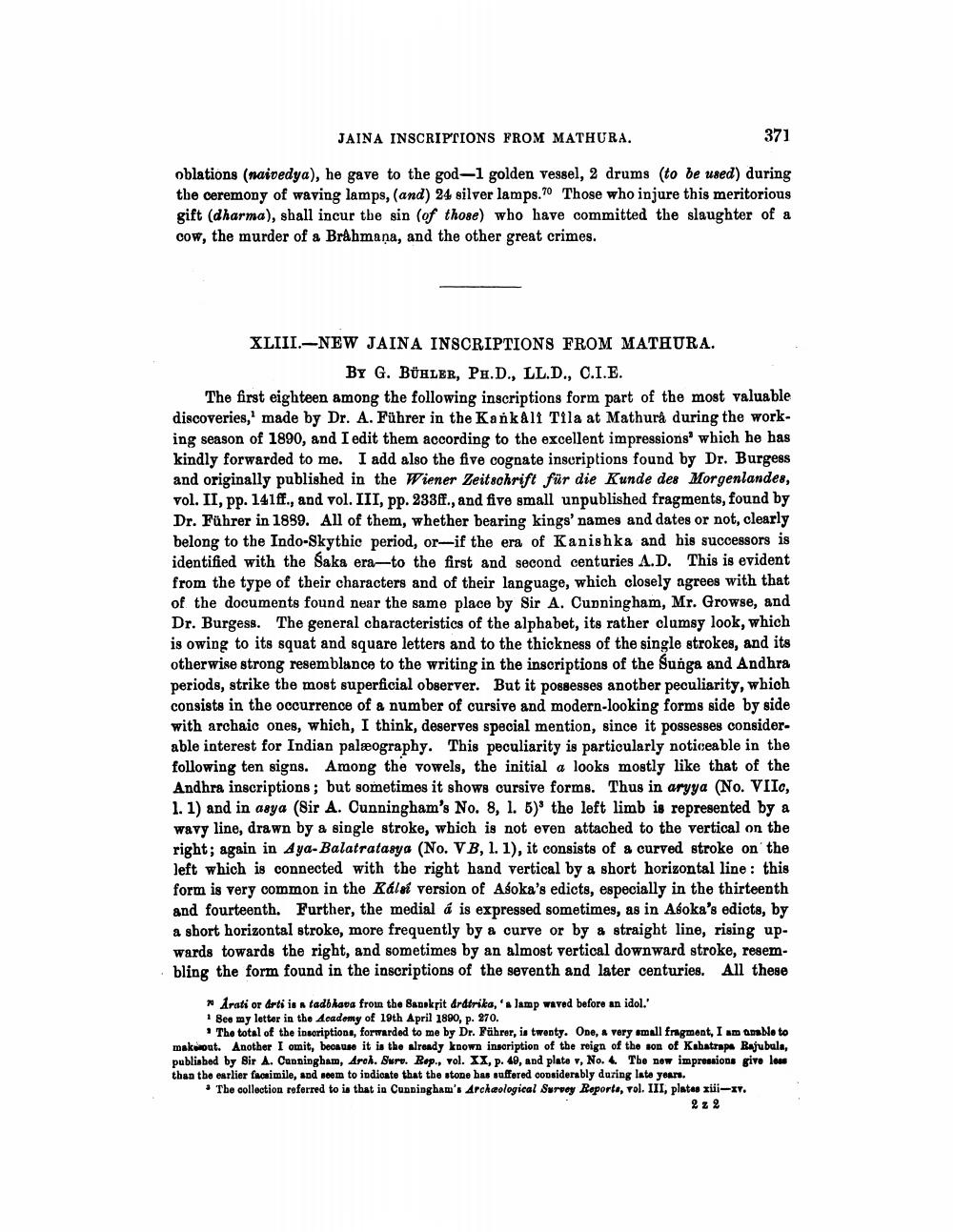________________
JAINA INSCRIPTIONS FROM MATHURA.
371
oblations (naivedya), he gave to the god-1 golden vessel, 2 drums (to be used) during the ceremony of waving lamps, (and) 24 silver lamps.70 Those who injure this meritorious gift (dharma), shall incur tbe sin (of those) who have committed the slaughter of a cow, the murder of a Brahmana, and the other great crimes.
XLIII.-NEW JAINA INSCRIPTIONS FROM MATHURA.
By G. BÜHLER, PH.D., LL.D., C.I.E. The first eighteen among the following inscriptions form part of the most valuable discoveries,' made by Dr. A. Führer in the Karkali Tila at Mathura during the working season of 1890, and I edit them according to the excellent impressions which he has kindly forwarded to me. I add also the five cognate inscriptions found by Dr. Burgess and originally published in the Wiener Zeitschrift für die Kunde des Morgenlandes, vol. II, pp. 141ff., and vol. III, pp. 233ff., and five small unpublished fragments, found by Dr. Führer in 1889. All of them, whether bearing kings' names and dates or not, clearly belong to the Indo-Skythic period, or-if the era of Kanishka and his successors is identified with the Saka era-to the first and second centuries A.D. This is evident from the type of their characters and of their language, which closely agrees with that of the documents found near the same place by Sir A. Cunningham, Mr. Growse, and Dr. Burgess. The general characteristics of the alphabet, its rather clumsy look, which is owing to its squat and square letters and to the thickness of the single strokes, and its otherwise strong resemblance to the writing in the inscriptions of the Sunga and Andhra periods, strike the most superficial observer. But it possesses another peculiarity, which consists in the occurrence of a number of cursive and modern-looking forms side by side with archaic ones, which, I think, deserves special mention, since it possesses considerable interest for Indian palæography. This peculiarity is particularly noticeable in the following ten signs. Among the vowels, the initial a looks mostly like that of the Andhra inscriptions ; but sometimes it shows cursive forms. Thus in aryya (No. VIIc, 1.1) and in asya (Sir A. Cunningham's No. 8, 1. 5)' the left limb is represented by a wavy line, drawn by a single stroke, which is not even attached to the vertical on the right; again in Aya-Balatratasya (No. VB, 1. 1), it consists of a curved stroke on the left which is connected with the right hand vertical by a short horizontal line : this form is very common in the Kálsi version of Asoka's edicts, especially in the thirteenth and fourteenth. Further, the medial á is expressed sometimes, as in Asoka's edicts, by a short horizontal stroke, more frequently by a curve or by a straight line, rising upwards towards the right, and sometimes by an almost vertical downward stroke, resembling the form found in the inscriptions of the seventh and later centuries. All these
Arati or arti is a tadbhava froin the Bapokrit ardtrika,' s lamp waved before an idol.' see my letter in the Academy of 19th April 1890, p. 270.
The total of the insoriptions, forwarded to me by Dr. Führer, is twenty. One, a very small fragment, I am unable to makwoat. Another I omit, because it is the already known inscription of the reign of the son of Kshatrapa Rajubala, published by Sir A. Canningham, Arol. Suro. Rep., vol. XX, p. 49, and plate v, No. 4. The new impressions give los than the earlier facsimile, and seem to indicate that the stone has suffered considerably during late years. • The collection referred to is that in Cunningham's Archeological Survey Reports, vol. III, plates xi-IT.
2 z 2




